
Have you ever had the opportunity to witness the magnificent spectacle of the sun rising and setting? It is an absolutely captivating experience. The appearance of the sun as it emerges or disappears from the horizon is influenced by various factors such as weather conditions, the presence of clouds, or even fog. As a result, the sky undergoes a stunning transformation, transitioning from vibrant shades of red to delicate hues of pink and even deep purples. Similarly, as the sun completes its daily journey and descends below the horizon, the clouds seem to ignite, creating a breathtaking display of fiery colors. If you have ever wondered about the scientific explanations behind these mesmerizing phenomena, continue reading this enlightening article.
What causes variations in the colors of sunsets?
Nature presents us with a fascinating phenomenon: the vibrant colors of sunsets and sunrises. But what causes the sky to be painted in such a mesmerizing way? The answer lies in the presence of suspended dust particles in the atmosphere, which are larger than the molecules of air. As the rays of light pass through these particles, they get refracted and transform the sunset or sunrise into a magnificent red glow. This realization might be disheartening, as it suggests that the air we breathe is not as pure as we perceive it to be.

However, the reason for the pink sky at dawn is not always pollution in the atmosphere. There are also natural and harmless occurrences that contribute to the scarlet hue. One such phenomenon occurs when suspended particles of salt and water vapor combine to create a vivid red sunset over the ocean’s surface. This mesmerizing sight can be observed from the shoreline.

The impact of volcanic eruptions
Volcanic eruptions release airborne debris and ash into the atmosphere, which can be carried by the wind over long distances. As a result, in areas far away from the eruption site, stunning red-orange sunsets can be observed. Notable examples of this phenomenon include the picturesque sunsets in the northern hemisphere following the eruptions of El Chichon in 1982 and Pinatubo in 1991.
In the immediate aftermath of a volcanic eruption, the atmosphere becomes heavily laden with dust and pollutants, creating a veil that blocks even red light. As a result, the sun appears to disappear before it reaches the horizon.

Characteristics of sunrise and sunset
Since our time in school, we have learned that the light that enters the atmosphere of the planet is white, meaning it contains all spectrums. The molecules in the air disperse the light into different wavelengths. This phenomenon is evident when we see a rainbow after rainfall, as the water droplets refract rays of varying lengths.
The colors we observe during sunrise or sunset are influenced by the path of light and the sensitivity of our eyes. The sun’s rays create a unique optical effect, illuminating the earth’s surface and the sky.

During daylight hours, when the sun is positioned high in the sky, its rays take a direct route to the Earth. These rays do not have enough time to disperse, resulting in their intense brightness that can be blinding. As a result, we perceive the sky as blue during this time. However, in the evening, the sun’s rays have to travel a longer path as they reach the Earth at an angle rather than directly. The shorter wavelengths of the blue spectrum get scattered, making them less visible to our eyes. On the other hand, we can clearly see the longer wavelengths of the red spectrum, which have the highest wavelength. These longer wavelengths are able to pass through the Earth’s atmosphere without getting scattered, especially as the sun moves from its highest point to the horizon.
During sunrise and sunset, the sky displays a stunning array of colors – although not all at once, of course. It’s possible to witness shades of purple, yellow, orange, and even green. The specific colors that appear depend on various factors, such as the weather conditions, the clarity of the air, and the angle of the Earth.
The impact of clouds
Clouds in the sky enhance the beauty and awe-inspiring nature of dawn and dusk. They capture the vibrant rays of light during sunrise or sunset, causing them to refract and create a mesmerizing display.

I reside on the outskirts of the urban area. Each morning, I observe the sunrise through the windows of my apartment that face east. The appearance of the sunrise varies significantly. It is dependent on the prevailing weather conditions and the particular time of the year. An important factor is the presence of the sea to the right of my house, which also influences the characteristics of the sunrise.
At one point, I pondered the reason behind the reddish-orange hue of the sunrise when the earth is enveloped in thick fog. The explanation lies in the initial rays of the ascending sun gliding across the surface of the fog-covered earth and penetrating the exceptionally high humidity. As a result, the majority of the light spectrum gets absorbed, leaving only the red and orange hues visible to the human eye.
The sky’s beauty has been depicted countless times by artists, described by writers and poets, and even those who are far from the world of art find themselves drawn to this captivating abyss. They gaze at it in awe, unable to find the words or emotions to fully express the feelings that stir their soul and mind. The vastness of the sky attracts people from all walks of life, with its crystal blue expanse and the mesmerizing movement of white-gray clouds that shift and transform into fluffy cumulus “lambs.” Even when the sky is melancholic, shrouded in darkness and overwhelming in its sheer mass, it still evokes a storm of emotions and experiences, igniting a unique train of thought.

Beauty lies in the eyes of the beholder
Every individual has a unique perception of the world. Some may find it gloomy and dull, while others see it as a vibrant and colorful place. Our interpretation of the sky above is also subjective. Considering a person with normal color vision, they would see the sky as it is commonly known – blue, gray, pinkish during sunset, and smoky-blue at dawn.
In reality, these colors are merely a result of how our eyes and brain perceive them. The easiest way for the human eye to comprehend an overcast sky is by seeing it as gray. On clear days, we see a vast expanse of azure above us, but in truth, the atmospheric dome appears closer to a violet hue when observed from Earth.

Endless expanse of sky above
Above the lands of European nations, the atmosphere during the summer months typically impresses with its vibrant azure shade. At times, one might even describe it as a deep and profound blue. Nevertheless, if we were to spend just a single day gazing overhead and attentively observing the natural phenomena, we would discern a subtle variation in color, which undergoes significant transformation from the instant the sun rises to the moment it finally sets.
During the summer months, the sky appears exceptionally clear and visually expansive due to the low levels of humidity and the absence of abundant clouds. Unlike in other seasons, where clouds accumulate water and gradually descend closer to the ground, the summer sky remains free from such obstructions. This lack of interference allows our gaze to extend beyond just a few hundred meters, reaching distances of 1-1.5 km. As a result, we perceive the sky to be vast and radiant, with its uninterrupted path of light rays in the atmosphere preventing refraction and enabling our eyes to perceive its brilliant blue color.

Reasons behind the Changing Colors of the Sky
The phenomenon of the sky changing colors is explained by scientific principles, albeit not as eloquently as depicted by writers. It is referred to as the diffuse radiation of the sky. To put it simply and in a way that is easily understandable for readers, the process of color formation in the sky can be explained as follows. Sunlight, which emanates from the sun, passes through the Earth’s atmosphere, causing it to scatter. This process is more pronounced with shorter wavelengths. When the sun is at its highest point above our planet, observers outside its direct path will perceive the sky to be the brightest and most intensely blue in color.
Nevertheless, during the sunset or sunrise, the sun’s rays intersect the Earth’s surface at an oblique angle, causing the emitted light to travel a greater distance and become more dispersed in the atmosphere compared to daytime. Consequently, individuals observe the morning and evening sky adorned with hues of pink and red. This occurrence is particularly pronounced when the sky directly above is covered by clouds. In such instances, the clouds appear remarkably vibrant, as the setting sun’s glow drenches them in a breathtaking array of scarlet shades.
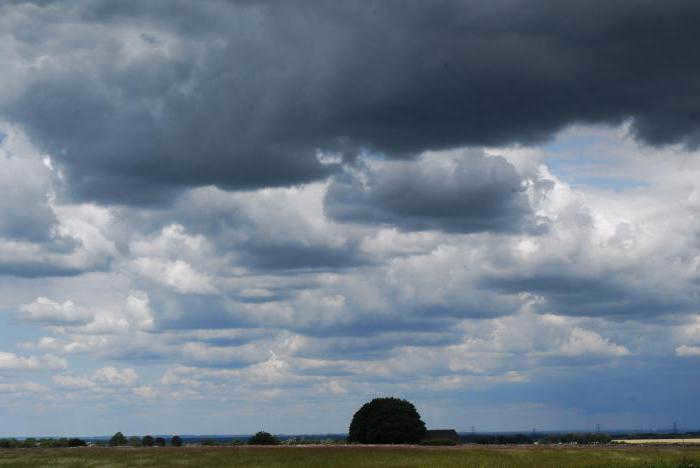
Steel of the Storm
But what exactly is an overcast sky? How does it come to be? This natural phenomenon plays a crucial role in the water cycle. As water vapor rises into the atmosphere, it encounters cooler temperatures at higher altitudes. As the vapor accumulates and cools, it condenses into droplets. Initially, these droplets appear as small, beautiful white cumulus clouds. However, as the droplets grow larger, the clouds take on a more grayish hue.
A vast hazy expanse.
There are occasions when the grey overcast sky lacks any gaps. This occurs when the concentration of clouds is exceedingly high, encompassing the entire visual space above. At times, they are perceived as an immense oppressive mass on the verge of collapsing overhead. Furthermore, this phenomenon is most prevalent during the autumn and winter seasons, when the air temperature is low, but the humidity, conversely, is high, reaching levels of 80-90%.
On such days, clouds hover perilously close to the Earth’s surface, positioned just a mere hundred or two meters above it. Descriptions of the overcast skies frequently evoke feelings of melancholy and depression, likely stemming from the emotions that arise when one feels isolated in the presence of this somber vastness, poised to drench and chill them.


What if things were different…
The color of the sky is determined by the amount of light and the wavelengths that reach the Earth. In winter, even on clear days, the sky appears blue. However, as spring approaches and the sun’s position gets higher, the blue becomes brighter, especially when the haze in the upper atmosphere fades, allowing more light to penetrate.
Scientists have discovered that the sky on other planets may not have the typical blue or gray colors. For instance, on Mars, the sky appears pink even during the daytime.
Antarctica, the world’s coldest continent, boasts an average temperature of approximately -50 degrees Celsius. Although it lacks a permanent population, the icy land is home to numerous research stations. With scientists constantly rotating, up to 4,000 individuals reside on this frigid continent depending on the season. Recently, a breathtaking sight captivated researchers, prompting them to rush outside with smartphones and cameras. The sky above Antarctica was adorned in a stunning hue of pink that gradually transitioned to shades of purple and blue. Eager to share this awe-inspiring spectacle, scientists promptly published the unaltered photos on the internet. They assure viewers that the images accurately depict the sky as they witnessed it, leaving them to speculate on the cause of this extraordinary natural phenomenon.
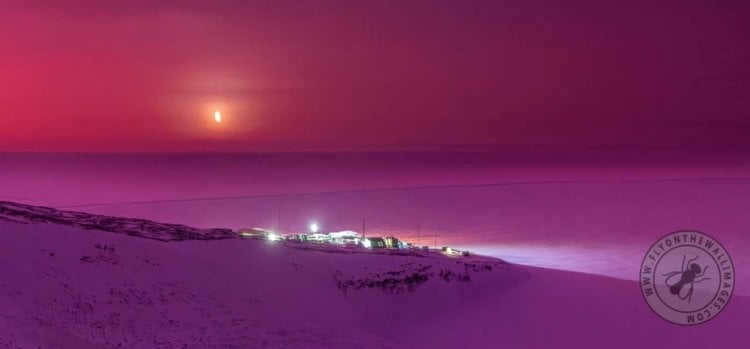
The sky in Antarctica has taken on a pink hue, but what is the reason behind this phenomenon?
Exploring the Pink Skies of Antarctica
According to scientific technician Stuart Shaw, the typical color of the sky over Antarctica during the middle of winter is a deep black. However, there is a small window of time near midday when a slight “sea twilight” can be observed. Recently, residents of the research stations have noticed a surprising change – the sky has been turning pink. Excited by this unusual natural occurrence, everyone rushed outside to capture photos of the stunning sight. Among the photographers, Stuart Shaw, with his extensive experience, managed to capture the best shots. He decided to share the unedited photos, showcasing the true beauty of the pink sky phenomenon.
“…the researcher stated that the majority of the station personnel hastily donned their jackets and hurried outside, armed with their cameras, in order to witness the breathtaking luminosity,”


Behold another captivating image showcasing the captivating pink sky over Antarctica.
Does internet exist in Antarctica and the Arctic? Learn more by clicking here.
Scientists theorize that the color of the Antarctic sky has undergone a transformation as a result of an eruption from a submerged volcano. This phenomenon occurred within the deep Tonga Trench, situated in the Pacific Ocean. As a consequence of this occurrence, an assortment of aerosols, predominantly composed of sulfate particles, were dispersed into the atmosphere. These particles, in conjunction with water vapor particles, have caused a distortion in the light that reaches the Earth’s surface. Consequently, the sky has taken on a unique hue, displaying shades of pink, blue, and purple.

The sky’s color alteration was a result of aerosols and water particles.
It is thought that the eruption of the submerged volcano happened in January 2022. The resulting impact is still noticeable half a year later because aerosols have a tendency to persist in the atmosphere for extended periods. The reflective characteristics of aerosols are undoubtedly responsible for the alteration in the sky’s color. This is supported by data obtained from the National Institute of Water and Atmospheric Research of New Zealand, which indicates the absence of aerosols over Antarctica prior to this event.
According to researcher Jordy Hendrikx, the captivating wonders of Antarctica never cease to amaze, as nature continues to display its breathtaking beauty and formidable power.
The Spectacular Phenomenon of Multicolored Snow in Antarctica
Indeed, occurrences of such natural phenomena are quite frequent in Antarctica. In early 2020, researchers at one of the scientific stations observed a peculiar phenomenon – the snow at their base had turned a vibrant shade of red. This eerie transformation bore a striking resemblance to scenes from horror movies. However, upon closer examination of snow samples under a microscope, it was determined that there was nothing to fear. The red coloration was attributed to the presence of single-celled algae known as snow Chlamydomonads (Chlamydomonas nivalis). These algae are commonly found in various cold regions around the world and typically lie dormant during the winter months. However, during the summer season in Antarctica, the algae had blossomed and brought about the striking red hue of the snow.
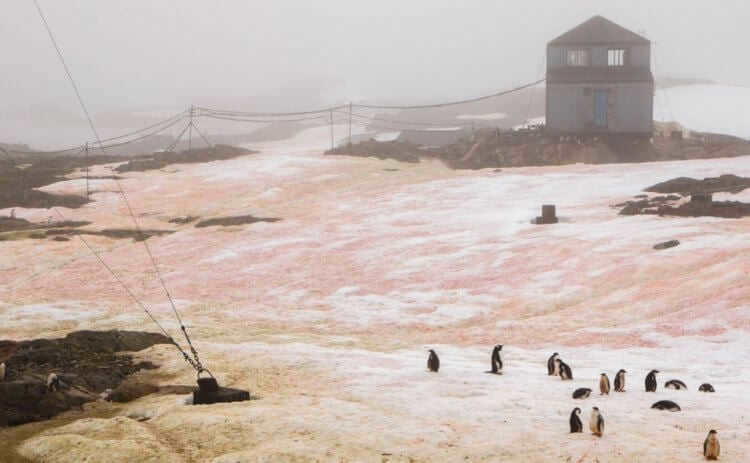
Occasionally, snow in Antarctica exhibits unusual colors, such as red and green hues.
Make sure to subscribe to our Telegram channel as we approach a milestone of 8,000 followers!
Several months later, my colleague Lyubov Sokovikova informed me about the discovery of green snow in Antarctica. This was not just a small patch near any of the research stations – there were approximately 1700 green patches in total. The finding was based on satellite imagery captured by the Sentinel-2 spacecraft. This occurrence is far from harmless, as the algae covered an area of around 2 square kilometers. Scientists estimate that this amount of algae can release up to 500 tons of carbon into the atmosphere annually, causing irreparable damage. Learn more about the greening of Antarctica and the dire consequences of this phenomenon here.
Discover the reason behind the pink hue that graces the sky during sunset. Let’s explore the scientific explanation behind this phenomenon and examine how the alteration in the angle of light refraction influences the evening sky’s color.
The evening sky, adorned with delicate shades of pink, stands as one of nature’s most awe-inspiring and exquisite occurrences. As the sun begins its descent below the horizon, its rays traverse the atmosphere and interact with molecules and aerosols, resulting in a transformation of the sky’s color.
The primary factor that influences the appearance of the pink hue in the evening sky is light scattering. During sunset, the sun’s rays follow a lengthier path through the atmosphere compared to noon. Along this journey, they encounter air molecules, aerosols, and dust particles, leading to the scattering of light in various directions.
Light with shorter wavelengths, like blue and violet, scatters more than light with longer wavelengths, like red and orange. As a result, when the sun is low on the horizon, it appears red or orange, and its rays, bouncing off molecules and particles in the atmosphere, tint the sky with pink hues.
Fascinating fact: depending on the atmosphere’s composition and the amount of particles in the air, the pink color of the sky can vary in intensity. In some regions, it can be more vibrant and saturated, while in others, it may be lighter and more delicate.
Therefore, the evening pink sky is the outcome of the intricate interaction between light and the Earth’s atmosphere. This remarkable phenomenon lends a touch of magic to sunsets and creates a unique ambiance of romance and enchantment.
The occurrence of a pink sky
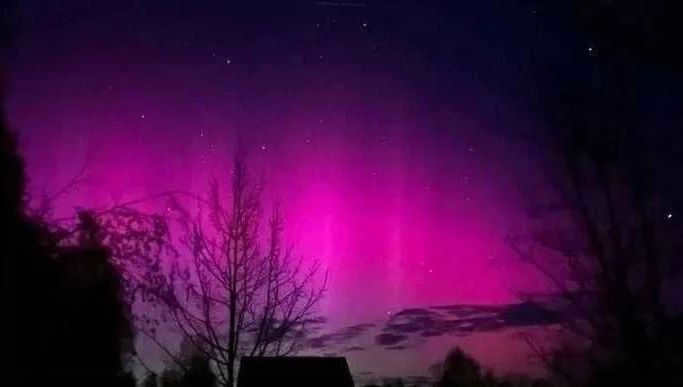
The occurrence of a pink sky is one of the most remarkable and stunning natural phenomena. During the evening, as the sun starts to descend below the horizon, the sky often adopts a pink tint that creates a unique ambiance and captivates onlookers.
The pink sky can be attributed to the optical characteristics of the atmosphere and the interaction between sunlight, aerosols, and air molecules.
When the sun is positioned high above the horizon, its rays traverse a shorter path through the atmosphere and are primarily scattered by air particles like oxygen and nitrogen molecules. Consequently, the sky typically appears blue in color.
When sunlight passes through the Earth’s atmosphere at an angle, it interacts with particles such as dust, smoke, or water droplets that may be present in the air. These small particles scatter light, with shorter wavelengths being scattered more. This scattering process causes the red and orange rays of the sun to scatter and reflect in the sky, creating a pink hue.
The pink sky phenomenon can also be intensified by the presence of clouds, which can reflect and disperse the colored rays of the sun. When clouds are close to the horizon, they can reflect pink light, making the sky even more vibrant and stunning.
In summary, the pink sky phenomenon occurs due to a complex interaction between light, the atmosphere, and aerosols. This natural phenomenon can be observed in various parts of the world and adds a touch of magic and beauty to sunsets.
Watch a Video on the Subject:
Scattering of Light
The scattering of light refers to the phenomenon where light changes direction as it passes through a medium containing particles. This occurrence is responsible for the beautiful pink hue of the evening sky.
The primary process accountable for light scattering in Earth’s atmosphere is known as Rayleigh scattering. Rayleigh scattering occurs when light interacts with air molecules and scatters in various directions.
Due to Rayleigh scattering, light with shorter wavelengths, such as blue and violet, is more strongly scattered compared to light with longer wavelengths, such as red and orange. This is why the sky appears blue during the day, as blue light scatters in all directions while other colors are absorbed by the atmosphere.
However, during the evening hours, when the Sun is positioned below the horizon, the light travels through a denser layer of the atmosphere. During this time, the phenomenon of Rayleigh scattering becomes less effective, causing longer wavelengths of light like red and orange to scatter less compared to blue light. As a result, the sky takes on a pink hue during the evening.
It is important to mention that light scattering can also be influenced by other factors such as atmospheric particles, dust, smoke, and fog. These particles can also scatter light, contributing to the overall coloration of the sky.
Therefore, light scattering is a physical process that explains the pink coloration of the evening sky. Rayleigh scattering plays a significant role in this phenomenon by scattering shorter wavelengths of light and allowing longer wavelengths to dominate, ultimately resulting in a pink sky color.
The positioning of the sun and its impact
One of the contributing factors to the rosy hue of the sky during the evening is the positioning of the sun and the angle at which its rays hit the Earth’s surface. Throughout the day, the sun ascends in the sky, reaching its highest point at noon, where its rays make direct contact with the Earth. During this time, the light reflects off the atmosphere, creating a perception of bright white light.
However, as the evening approaches, the sun gradually descends towards the horizon, causing its rays to pass through a thicker layer of the atmosphere. As a result, the light scatters, allowing the longer wavelengths (such as red and orange) to become more prominent. This phenomenon accounts for the pinkish hue that colors the evening sky.
Therefore, the position at which the sun’s rays hit the Earth’s atmosphere and the dispersion of light in the air are vital factors in forming the rosy tint of the sky during the evening hours. This occurrence grants us the chance to relish in stunning sunsets and establishes a one-of-a-kind ambiance as the day draws to a close.
Question and Answer:
What causes the evening sky to appear pink?
The evening sky appears pink due to a phenomenon known as Rayleigh scattering. The Earth’s atmosphere contains gas molecules that scatter light. When sunlight passes through the atmosphere, it interacts with these molecules and scatters. Although sunlight contains all colors of the spectrum except for pink, the pink color is created as a result of the specific scattering patterns of light in the atmosphere. The scattering causes the sunlight to be mainly composed of red and orange shades, giving the sky its pink hue.
What are the factors that influence the color of the evening sky?
Various factors contribute to the color of the evening sky. The angle at which the sun’s rays hit the atmosphere is one of the primary factors. As the sun sets, its rays pass through a thicker layer of the atmosphere, causing more scattering of light. This scattering leads to the creation of a pink hue in the sky. Additionally, the composition of the atmosphere, including the presence of aerosols and dust, can also impact the color of the evening sky.
What causes the evening sky to appear red?
The evening sky can turn red due to the scattering and reflection of the sun’s rays by larger air particles, such as dust or volcanic ash, as they pass through the atmosphere. These particles scatter light with shorter wavelengths, making red and orange colors more pronounced. This occurrence is particularly prevalent following significant forest fires or volcanic eruptions.
Under specific atmospheric conditions and optical phenomena, the evening sky has the ability to transform into a mesmerizing shade of purple. This enchanting spectacle occurs when the air is filled with elevated levels of aerosols or dust particles, allowing sunlight to penetrate and scatter through the atmosphere. As a result, the vibrant hues of violet and blue take center stage, creating the illusion that the sky is undergoing a stunning transformation into a mystical shade of purple.
What causes the sky to appear pink instead of any other color?
During the evening, the sky takes on a pink hue due to the way that light scatters in the atmosphere. The molecules in the air scatter the sun’s rays in all directions. However, when the sun is below the horizon in the evening, the light passes through a thicker layer of the atmosphere. As a result, short-wave colors like blue and green scatter more than long-wave colors such as red and orange. When this scattered light reaches our eyes, it contains a higher concentration of red and orange, which gives the sky its pink color. In contrast, other colors like violet or yellow do not scatter as much and are not as visible in the evening sky.
Study of Atmospheric Optics
The field of atmospheric optics focuses on the examination of various phenomena that occur when light travels through the Earth’s atmosphere. It aims to provide an explanation for the changing colors of the sky throughout the day and the occurrence of optical effects like rainbows and halos.
Light scattering is a significant factor that influences the color of the sky. The presence of dust particles, water molecules, and other small objects in the atmosphere causes light to scatter in all directions. Consequently, shorter wavelength light, such as blue and violet, scatters more than longer wavelength light, such as red and orange. Therefore, the sky typically appears blue during daylight hours and can take on pink or orange hues during the evening.
Another fascinating occurrence linked to atmospheric optics is the rainbow. Rainbows materialize as sunlight passes through raindrops suspended in the atmosphere. The light undergoes reflection and scattering within these droplets. Due to the varying angles of reflection and scattering for different colors of light, we perceive distinct bands of colors in a rainbow.
Halo, on the other hand, represents another optical phenomenon arising from the scattering of light in the atmosphere. This celestial spectacle forms when light interacts with ice crystals present in the atmosphere. As these crystals scatter light, they create a circular halo surrounding a luminous source such as the Sun or Moon.
The significance of atmospheric particles
The scattering of light by atmospheric particles is a major factor in the phenomenon of the evening sky turning pink. Atmospheric particles come in various sizes and compositions, but they all play a crucial role in influencing the color spectrum of the sky.
When the Sun is positioned low above the horizon, its rays have to pass through a thicker layer of atmosphere compared to noon. Consequently, the light encounters more atmospheric particles, causing it to scatter in different directions. This results in the stronger scattering of light with shorter wavelengths like blue and green, while light with longer wavelengths such as red and orange maintains its intensity.
This is the reason why the evening sky appears pink. As the Sun goes below the horizon, its rays pass through a denser layer of the atmosphere and get scattered by more particles. This causes a greater scattering of shorter wavelength light and results in a pink hue.
Furthermore, atmospheric particles can also reflect and scatter light from other sources like cities and industrial plants. This can introduce additional shades and colors to the celestial scenery.
It’s worth noting that the composition of atmospheric particles can vary depending on the location and environmental conditions. In areas with high air pollution, for instance, atmospheric particles may be larger and have a different chemical composition, which can impact the color of the evening sky.
Therefore, it is undeniable that atmospheric particles play a crucial role in the creation of pink skies during the evening. Their remarkable capability to disperse light with varying wavelengths results in the mesmerizing and distinct color spectrum that we are able to witness each and every night.
Pink Color and Wavelengths

Pink is a color that is often considered to be visually appealing and captivating. It is commonly associated with qualities such as tenderness, romance, and beauty. However, have you ever wondered why the sky sometimes appears pink during the evening?
In order to understand this fascinating phenomenon, it is essential to have a basic understanding of how colors are naturally formed. The perception of color is a result of the human eye detecting different wavelengths of light. Each individual color has its own unique wavelength, which ultimately determines how we visually perceive it.
The color pink is actually a combination of red and white. The color red specifically has a wavelength that falls within the range of approximately 620-750 nm, while white is a composite of all the colors within the visible spectrum.
This is the reason why the evening sky appears pink. When sunlight passes through the atmosphere, the red and orange rays are able to penetrate and light up the sky, resulting in this lovely and romantic color.
Consequently, the pink hue of the evening sky is caused by the scattering of light in the atmosphere and the specific characteristics of various color wavelengths. This natural occurrence produces a one-of-a-kind ambiance and brings joy to people with its captivating beauty.
The impact of pollution on the sky’s color
Pollution in the environment has a significant influence on the color of the sky and can result in a shift in its hue. This effect is particularly noticeable in urban areas where there is a higher concentration of pollutants in the air.
One of the primary reasons for changes in sky color as a result of pollution is the scattering of light by particles emitted by pollutants. When sunlight passes through the atmosphere, it interacts with both air molecules and particles. As pollution levels increase, the amount of particles and molecules that the light interacts with also increases, causing a more pronounced alteration in its color.
The most prevalent type of pollution that impacts the color of the sky is atmospheric pollution caused by emissions from factories, vehicles, and household heating systems. These emissions contain harmful substances like nitrogen, sulfur, and carbon oxides.
The primary contributors to the formation of smog and fog, which can alter the sky’s appearance, are nitrogen and sulfur oxides. The presence of these pollutants causes the scattering of light, resulting in a gray or yellowish tint in the sky. Furthermore, carbon particles emitted from vehicle exhaust and fuel combustion can also contribute to a gray or black coloration in the sky.
Pollution can further impact the sky’s color by affecting the refraction of light. As light passes through a polluted atmosphere, it becomes dispersed in various directions, leading to a change in color. For instance, if there is a high concentration of dust in the air, the sky may take on a pinkish hue.
Therefore, the color of the sky is greatly impacted by environmental pollution. It can result in a sky color that is gray, tinged with yellow, or even pink, and it can also cause alterations in the way light is refracted. This occurrence is just one of the adverse consequences of pollution and underscores the significance of tackling air pollution and maintaining a clean environment.
The romantic view of the pink sky
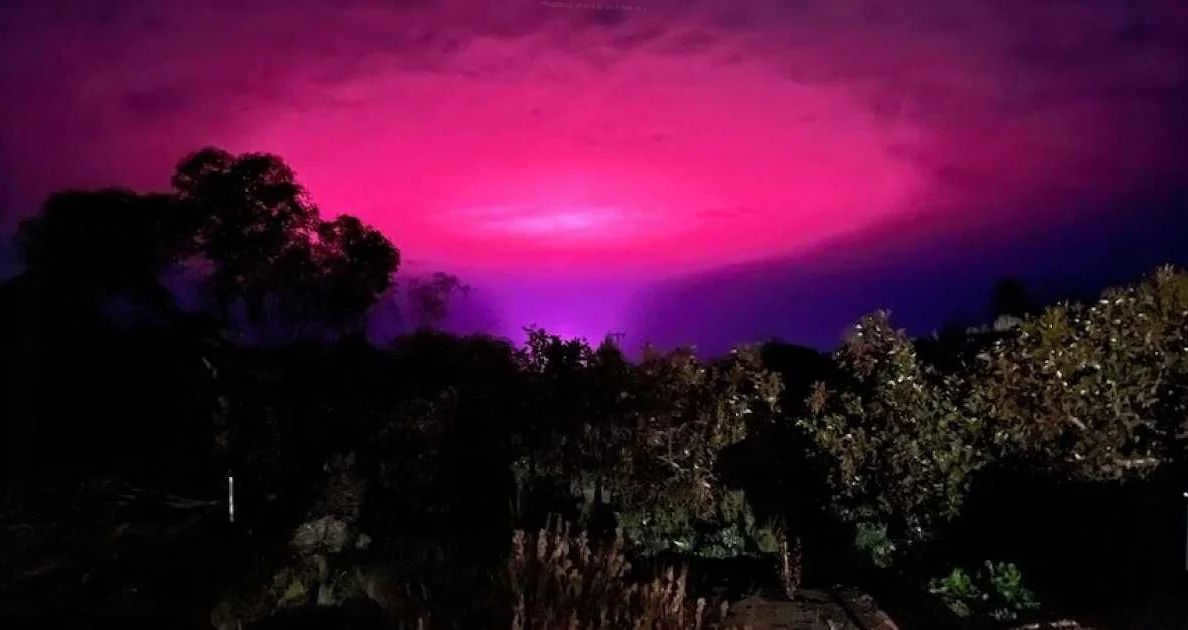
The evening sky turning pink often brings about a sense of romance and sets a unique ambiance. This phenomenon invokes feelings of joy and creativity, causing individuals to pause and appreciate the moment.
One of the most commonly accepted explanations for the pink hue in the evening sky is the scattering of light. As the sun nears the horizon, its rays pass through a thick layer of the atmosphere, resulting in light scattering. Consequently, the shorter wavelength rays (blue and violet) scatter more, while the longer wavelength rays (red and orange) remain more concentrated.
It is the red and orange rays that contribute to the pink tint of the evening sky. These rays bounce off clouds and other particles in the atmosphere, imparting a romantic hue to the sky. Furthermore, the presence of dust, smoke, or other pollutants in the air can enhance the pinkness of the sky.
The sight of pink skies can also elicit nostalgic memories and evoke intense emotions. It brings to mind picturesque sunsets, leisurely walks along the beach, or romantic evenings. In these moments, the pink sky creates a unique ambiance and intensifies the emotional experience.
Consequently, a pink sky during the evening evokes romantic perceptions and sets the stage for a special atmosphere. It is not solely the result of physical processes occurring in the atmosphere, but also the way we perceive and interpret the world around us.
Pink clouds are a frequent sight during the sunrise or sunset, painting the sky with their beautiful hues and providing visual delight to onlookers.
The pink or red skies we witness are a result of sunlight of varying wavelengths falling on the clouds. When the blue and green colors of the visible spectrum scatter more than the red and orange colors, the clouds take on shades of pink, red, or peachy tones.
When we think about clouds, we usually imagine either fluffy white clouds against a blue sky or dark gray clouds that bring rain. However, the Earth’s atmosphere is illuminated by sunlight, which causes the clouds to display a wide range of colors. All clouds consist of water vapor that condenses into clusters of water droplets or ice crystals. The colors that clouds exhibit depend on factors such as their size, altitude, and the angle of the sun. These water droplets or ice crystals form around dust particles, which serve as nuclei for condensation. The thickness of the clouds determines whether sunlight can pass through them, resulting in the clouds appearing white, or if only certain colors will scatter, creating a display of different colors. The occurrence of a pink sky during sunrise or
The occurrence of sunset is influenced by various factors, including the specific cloud type, the angle at which the sun’s rays hit the Earth’s atmosphere, and numerous other variables.
If you’re interested in delving deeper into the connection between pink sky and sunlight, continue reading to discover intriguing information about the phenomenon. Additionally, you might find these entertaining articles about the loftiest clouds in the sky and the weightier cloud formations interesting.
What Causes Pink Clouds?
Contrary to the common misconception that clouds generate their own colors, it might come as a surprise to discover that clouds are actually colorless.
However, during the time of day when the sun is rising or setting and its angle is at its smallest (10 degrees) in relation to the horizon of the Earth, the sunlight must travel a greater distance through the various layers of the atmosphere. When the white sunlight encounters a cloud in the troposphere, it acts as a prism and separates the white light into the seven colors of the visible spectrum. Consequently, colors with shorter or longer wavelengths are scattered. The green and blue light, which have shorter wavelengths, scatter so much that they become invisible, whereas the yellow, orange, and red light with longer wavelengths scatter less and give rise to the optical illusion of pinkish-red hues in the cloud cover. As a result, the sky and clouds appear pink during sunrise and sunset due to the sun’s lowest angle of inclination with respect to the horizon of the atmosphere.
The Advantages of Pink Clouds
Due to the fact that various types of clouds can provide insight into upcoming weather changes, pink clouds can also be useful in predicting weather conditions in a specific area.
Observing pink and fiery red clouds in the early morning can be captivating, but they can also signal the onset of dangerous weather conditions, such as a thunderstorm or tornado. Conversely, pinkish night skies are often referred to as a “sailor’s delight,” indicating that a high-pressure system and favorable weather conditions will follow after a period of intense thunderstorm activity. Pink clouds moving in from the west suggest that they are carrying moisture-laden clouds to another location, while pink clouds in the east at sunrise suggest the approach of heavy rainfall. Therefore, when a pink sky is seen in the west during the evening, signaling good weather, it is known as a sailor’s joy.
The enigma of rose-colored clouds
Now that you possess the knowledge regarding the primary cause of rose-colored clouds, there are no more enigmas remaining to be unraveled.
The initial explanation for rose-colored clouds is attributable to the shallow angle at which the sun intersects with the horizon during the sunrise and sunset. Additionally, the rose tint is produced within delicate clouds that possess a lower concentration of water molecules, thereby permitting a greater amount of pink light to permeate through them. Lastly, the rose-hued nocturnal sky can be clarified by the prevalence of extensive pollution in urban regions. An excess of dust and aerosols suspended within the atmosphere scatter and disperse light, allowing only light with a lengthier wavelength to endure, resulting in the appearance of pink clouds and a pinkish-red sky at night.


The Impact of Pink Clouds on the Environment
While pink clouds do not bring about significant environmental changes, they do play a role in weather prediction for the upcoming days.
Frequently, one may observe towering clouds of pink hue with a base of gray-blue. These particular clouds are known as cumulonimbus clouds, characterized by a grayish base and a dense concentration of water droplets above. They serve as a signal for an impending thunderstorm. In regions with temperate or colder climates, the presence of a pinkish hue in the sky indicates the occurrence of snowfall. When sunlight interacts with a thick cloud containing larger frozen water droplets, it is unable to pass through and is instead refracted. Consequently, the falling snowflakes or icy particles within the cloud act as prisms, causing the white light to scatter. Initially, this scattering primarily affects the shorter wavelength blue light, which eventually dissipates and becomes indiscernible. On the other hand, the longer wavelength light undergoes minimal scattering, resulting in a reflection of a pink hue through the cloud droplets. This reflection is what imparts the pink coloration to the sky during snowfall.
Fun fact!
Did you know that milky white cumulus clouds have water droplets packed so tightly that they prevent any white light from passing through? As a result, the other colors in white light are unable to refract and scatter, causing the clouds to appear bright white.
These white clouds are commonly seen in the morning when the sun is at a high angle to the horizon, creating a beautiful blue sky as the sunlight scatters due to its short wavelength.
On the other hand, blue-gray or gray clouds are associated with rainfall. Gray layered rain clouds typically bring drizzle, while cumulonimbus clouds are a sign of severe thunderstorms accompanied by lightning.
The formation of yellow clouds is dependent on the level of air pollution found within the city. When sunlight interacts with clouds that are composed of excessive dust or smoke from sources such as automobile fires, industrial emissions, forest fires, or volcanic activity, the result is the creation of yellow clouds. The presence of yellow clouds indicates an abundance of nitrogen oxides in the atmosphere, which is a direct result of pollution and can potentially lead to the occurrence of acid rain.
Unlike pink clouds, which are typically only visible during sunrise or sunset, yellow clouds can be observed at any time of the day.
Green clouds, or clouds that possess a greenish hue, are often indicative of the imminent arrival of severe weather conditions, such as thunderstorms or tornadoes. These weather events are often accompanied by lightning, thunder, and hail.
Rainbow clouds are an incredibly rare phenomenon that captivates the attention of avid sky gazers. When white light passes through the ice crystals of a thin and smoky cloud, such as a high-altitude cumulus cloud, the various colors of the rainbow become visible. This occurs because the different wavelengths of light are refracted as they pass through the cloud, resulting in the reflection of the rainbow’s vibrant hues.
At Kidadl, we have curated a diverse collection of fascinating family-oriented facts for everyone to enjoy! If you found our insights on the symbolism of pink clouds intriguing, why not explore our articles on the authenticity of rainbows or discover captivating facts about the enchanting rainforests of Australia?





